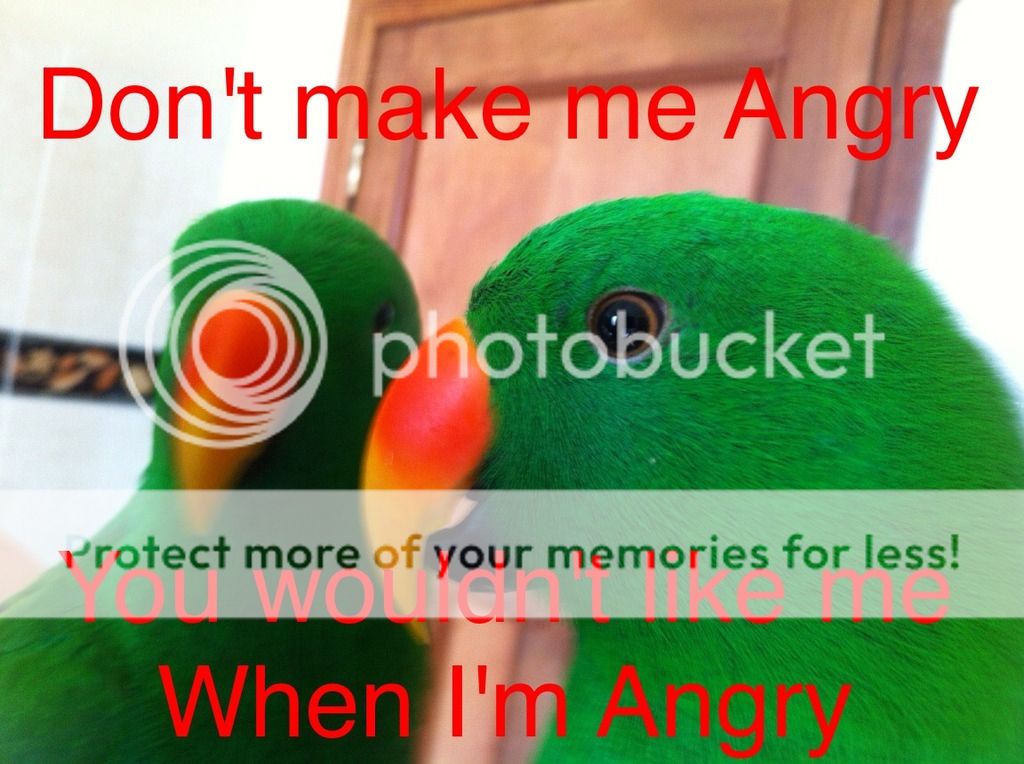- Dec 18, 2013
- 22,301
- 4,217
- Parrots
- Maya (Female Solomon Island eclectus parrot), Jolly (Male Solomon Island eclectus parrot), Bixby (Male, red-sided eclectus. RIP), Suzie (Male cockatiel. RIP)
Good video, Chris. Great way to avoid getting tagged. I personally shy away from that method for two reasons, though.
For one, any covering over the fingers or hands actually prompts an attack from Maya. How did I discover this? Because I once had the "bright" idea of wrapping my son's (Aidan's) hand in several layers of vet tape so he could try working with her. (Quick history. Maya has bonded to me. HARD. So she'll tolerate Aida to a point, but anyone else is fair game. Hormones or no. I want to socialize her more, but since she is more likely to draw blood than not, most people would rather not try. And without socialization volunteers...) I did this because Aidan has shown quite the facility for working with birds, and wanted to work with Maya. I have risked it with Jolly, who never bites, no problem. And Bixby before him, who hardly bit once he'd been pressure-trained. But Maya? Maya could put the fear of birds into him. Know what I mean?
Anyhow, I wrapped his hand and fingers with enough layers that I thought he'd be safe from her beak (his fingers looked like thick, mummified sausages) and gave him the go ahead to have Maya step up. Colossal mistake. Her eyes pinned immediately and she bit right THROUGH all the layers in less time than it takes to tell. By the time I'd pried her loose, poor Aidan was screaming, tears flowing down his little face.
So not only was I wrong about the layers upon layers being protection enough, but I'd also managed to trigger what I was hoping to prevent. (Btw, I don't know if this is the case with female ekkies in general, or just Maya specifically, but she bites maybe 2 times as hard as any male eclectus I've experienced. It's something about the substantive nature of her beak. And its shape. It's more dense, more solid. And sharper. And her bites are far more insistent and ferocious, too.)
And second, parrots tend to get a little comfortable biting on gloves. Like it's okay. And that's a problem. You see, birds tend to be creatures of habit. Which is why problems like plucking and self-mutilation, or to a lesser extent screaming and, yes, biting can be so difficult to break. Once they start to become comfortable with the idea of chomping on your glove, it's just not that much of a stretch for them to start doing it, out of habit, to your naked hand.
Granted, Chris pointed out that he'd be using the glove when he was rearranging the cage and such. So I get the idea that this wouldn't be a frequent practice for him. But I mention it for those who might want to adopt the practice more regularly for a bird who is more of a consistent bite risk.
Sent from my SM-N900V using Tapatalk
For one, any covering over the fingers or hands actually prompts an attack from Maya. How did I discover this? Because I once had the "bright" idea of wrapping my son's (Aidan's) hand in several layers of vet tape so he could try working with her. (Quick history. Maya has bonded to me. HARD. So she'll tolerate Aida to a point, but anyone else is fair game. Hormones or no. I want to socialize her more, but since she is more likely to draw blood than not, most people would rather not try. And without socialization volunteers...) I did this because Aidan has shown quite the facility for working with birds, and wanted to work with Maya. I have risked it with Jolly, who never bites, no problem. And Bixby before him, who hardly bit once he'd been pressure-trained. But Maya? Maya could put the fear of birds into him. Know what I mean?
Anyhow, I wrapped his hand and fingers with enough layers that I thought he'd be safe from her beak (his fingers looked like thick, mummified sausages) and gave him the go ahead to have Maya step up. Colossal mistake. Her eyes pinned immediately and she bit right THROUGH all the layers in less time than it takes to tell. By the time I'd pried her loose, poor Aidan was screaming, tears flowing down his little face.
So not only was I wrong about the layers upon layers being protection enough, but I'd also managed to trigger what I was hoping to prevent. (Btw, I don't know if this is the case with female ekkies in general, or just Maya specifically, but she bites maybe 2 times as hard as any male eclectus I've experienced. It's something about the substantive nature of her beak. And its shape. It's more dense, more solid. And sharper. And her bites are far more insistent and ferocious, too.)
And second, parrots tend to get a little comfortable biting on gloves. Like it's okay. And that's a problem. You see, birds tend to be creatures of habit. Which is why problems like plucking and self-mutilation, or to a lesser extent screaming and, yes, biting can be so difficult to break. Once they start to become comfortable with the idea of chomping on your glove, it's just not that much of a stretch for them to start doing it, out of habit, to your naked hand.
Granted, Chris pointed out that he'd be using the glove when he was rearranging the cage and such. So I get the idea that this wouldn't be a frequent practice for him. But I mention it for those who might want to adopt the practice more regularly for a bird who is more of a consistent bite risk.
Sent from my SM-N900V using Tapatalk

